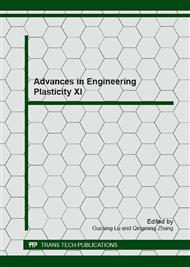p.223
p.227
p.231
p.235
p.239
p.243
p.247
p.250
p.254
A Numerical Approach to Shape Correction of Stamped Products Using Laser Forming Techniques
Abstract:
Laser forming is an advanced process in sheet metal forming in which a laser heat source is used to shape the metal sheet. In this paper, shape correction of stamped product using the laser forming technique is numerically invesitgaed. As a fundamental study, laser irradiated bending process has been analyzed through the thermo-mechanical FE analysis. Laser scanning experiments has been also conducted for varificaiton of numerical simulations. Finally, the laser forming technique is applied to the u-shaped channel member for springback compensation. It is observed that laser irradiation gives the desired bending angle to compensate the springback by controlling the process parameters such as the laser power, scanning speeds and the number of laser scanning.
Info:
Periodical:
Pages:
239-242
Citation:
Online since:
January 2013
Authors:
Price:
Сopyright:
© 2013 Trans Tech Publications Ltd. All Rights Reserved
Share:
Citation:


